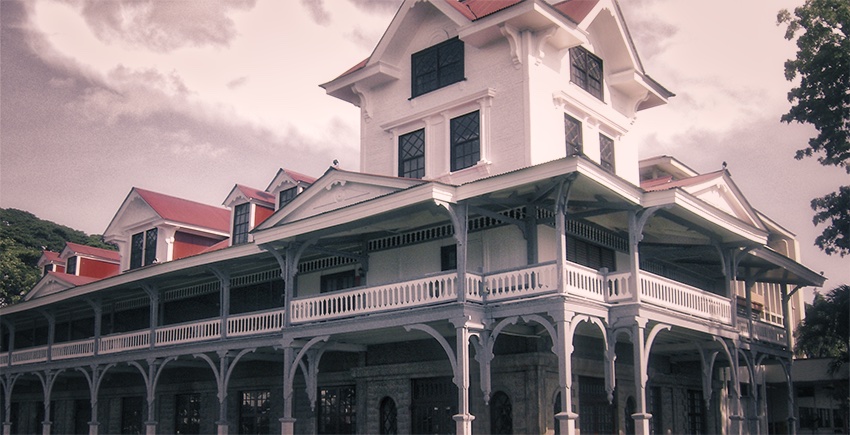
Words of Remembrance: Ruth Imperial Pfeiffer — “Woman of Music”
Words of Rememberance: “Time Was When”
Silliman Church, July 17, 2013
Time was when one could count on the fingers of one’s two hands, the number of concrete buildings on Silliman Campus, lovely looking cottages dotted the campus area with beautiful lawns cared for by those who lived in them, when families sat at the table for breakfast, lunch and supper, where conversations about ones day took place.
Time was when the gym area, the Ravello athletic field was playground and the Amphitheatre was swimming pool after days of heavy rain – a beautifully shaped mansanita tree, now cut-down, found near the Hibbard Hall, served as the perfect place to dry one-self while eating the ripe mansanitas, leftover of the birds.
Time was when this campus was a village, where parents were not only parents to their own children but other children, as well, with gentle reminders of “don’t climb too high, you might fall”, or when playing until sundown, “its time to go home now”.
Time was when there were children running about this eden of a campus with an air of ownership, safe, happy, noisy, carefree, called “ the faculty kids” – with a hierarchy of its own – the pecking order so well-defined, that if one was born two years younger, he or she belonged to a different generation described as “having milk in their mouth, sleep in their eyes and snut in their noses”, considered a living thing only when needed for games that required teams.
Time was when_English was spoken in and out of the classroom but sometimes in an effort to be identified in some special way, the homogenous age groups would have their own “ dialect”, in my generation, it was carabao language “Weper- apar-youpo-go-po-wi-ping”. In retrospect, it did not take a rocket scientist to figure that one out.
But through all that— a thread…no, a rope bound all these kids together, MUSIC. Music- piano, violin,voice, choir. Parents mandated it, the mentors made sure it happened and the role models encouraged it.
Time was when the Conservatory of Music, headed by Mercedes Magdamo became the center of activity for these energy-filled children of the campus. Piano and violin were the instruments of choice but Mrs. Magdamo, a singer herself, director for the church choir encouraged the “older” children to take voice lessons. At one recital , the older ones who were taking piano lessons were going to sing as well. We, of the younger generation, were asked to sit on benches – slabs of thick lumber with supports at each end with an admonition to be respectful when others were performing by being quiet. The only problem was our feet could not reach the floor. If we wiggled so much, we will fall face first. So, trick was keep to keep still. Now out comes Ruth and her accompanist. I would figure it was Precy because they were known that way: Ruth and Precy, Precy and Ruth. Ruth gives the audience a once-over, placed her hands in position to sing, gave her accompanist the nod to start. Not too many people realize how literally scary it is to perform in front of an audience. If one played the piano, the fingers would freeze but should they thankfully move, wrong keys were struck, feet tremble at the pedals, and one desperately wanted to go to the bathroom. But there was no turning back, one did what one was suppose to do, praying to finish sooner rather than later. It must be worse when one has to sing. Ruth must have been scared out of her wits but this friendly, funny, giggly Ruth, being the trouper she was, sang her song- the Hills of Home, her trembling voice giving away how nervous she was.
The coming of the Palmores brought another dimension to the music life of Silliman. Mimi Palmore was the Hammond organist for Silliman church. She picked three of us – offered this invitation, “would you like to study the hammond organ? I will teach you if you promise you will always serve the music ministry of the church.” Ruth, Mutya Lopez Solis and I accepted the invitation and the challenge, so for a number of years, we four alternately served as church organists. This group of organists grew in numbers through the years, of course, kids and finally other students who enrolled at Silliman.
Time was when it was easy to assume that if one had a college degree earned at Silliman, that degree was in music. Not quite. Ruth had a degree in English, some became chemists of note, biologists, engineers, doctors of medicine. All dabbled in music, some more seriously than others. Whatever music activity it was, be it The Campus Choristers, Folk Arts Ensemble, church choirs for the college, high school and elementary school, solo performances, voice, piano, violin, plays, musicales, faculty kids were involved.
Time was when all these children, grown up now, left this eden of a campus, to earn higher academic degrees, Ruth, to the Union Theological Seminary in New York for an MA in Sacred Music. She came back to Silliman briefly but left again to establish her home in Hawaii. On the invitation of former president, Dr. Quintin Doromal, she came back to campus to be Director of the School of Music and Fine Arts, Chairman of the Cultural Affairs Committee. We took turns as organist and director for choirs at Silliman Church.
An administrator’s job is never easy but Ruth kept her “cool”, never letting on when something upset her. I encouraged her to use her “administrator’s voice” sometimes, but she only smiles.
After one such day, inching our way down the long stairway of Guy Hall, a lady was waiting for her- calling out her name from the bottom of the steps. They hugged each other, in fact did a little circle dance, “how are you”, “you have not changed”…more circle dances and recalling of experiences. I stood by watching this exchange. As we boarded her tansan green Ford Fiera, she asks me, “who was that”? I said, “You don’t know her? You hugged and danced with promises to meet again and you don’t know her?” She does her delightful giggle and said, “walay batasan”.
It is of no surprise that Ruth’s request was for her cremains to be brought back to her “hills of home”, here where she grew up, happy and endearingly funny, where her faith in God and her commitment to His work was molded, chiseled and honed to become the woman of music we honor with this tribute tonight – holding her own wherever she found herself.
Here at Silliman Campus, where Time was when…
ABOUT THE AUTHOR :
Isabel Dimaya-Vista
Elementary (1947); High School (1951); AB Music (1955); Bachelor of Christian Education (1957);
Professor Vista continues to be active in the music ministry of the Silliman University Church.



